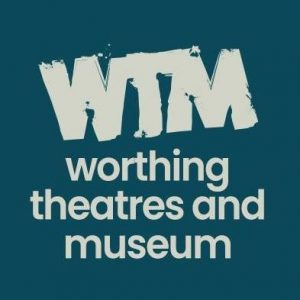
Thanks to a grant from South East Museums Development and the Arts Council, I was able to return to
Worthing Museum in January 2023 to conserve some of the metalwork items from the archaeology
collection. In this first blog we will have a look at the chosen objects, in the second blog we will have a
closer look at the objects from a conservation angle, and in the third blog I’ll be showing you the
treatments and discussing the reasoning behind them.
James Sainsbury – Curator of Archaeology – picked out some beautiful and rare pieces from the
displays, read on to discover more about them………
The Bronze Age display case is full of fascinating objects recovered from the local area, showing us a
glimpse of life from 2000BC to 700BC. I had previously treated the beautiful bronze flat-axe from this
display but this time we noticed that two ‘copper cakes’ could benefit from a surface clean.
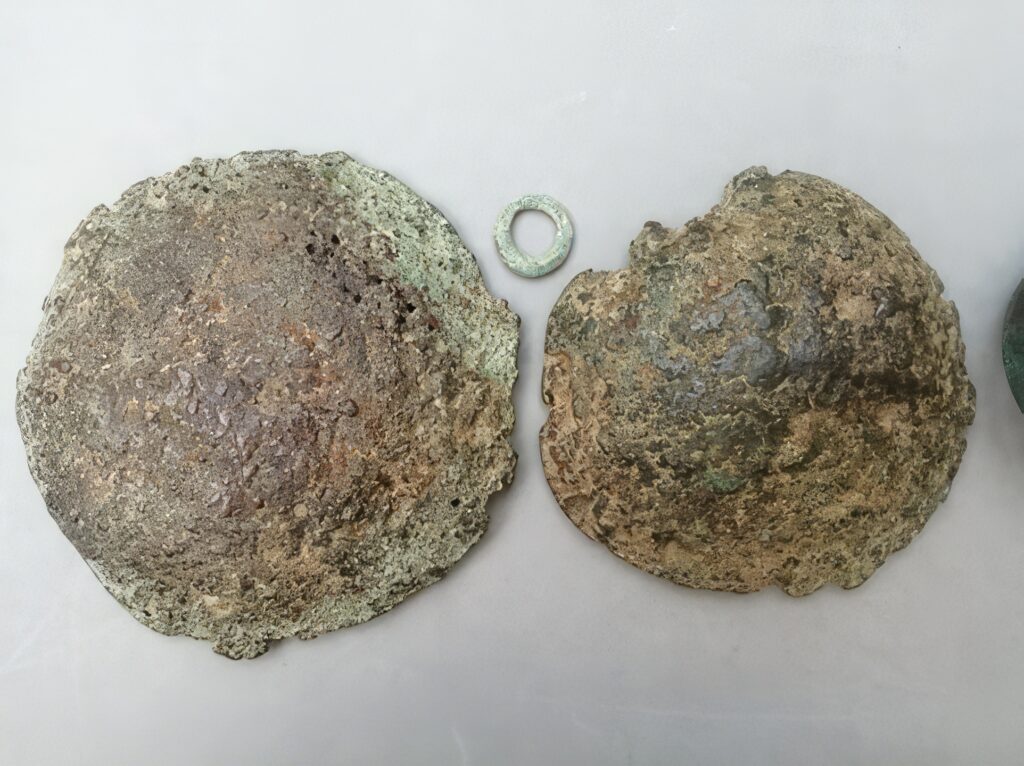
Copper cakes are essentially ingots of copper, in a rounded ‘bun’ shape, and would have been produced by a foundry to store, trade and transport processed metal. The cakes are in great condition considering
their age, but we wanted to investigate the surface more closely. This hoard – the Forty Acres Brickfield Hoard was discovered by Brooklands Park in 1877, which would have been an inlet of the sea 3000 years ago, suggesting they were brought in by sea, and a selection is on display in the museum.
We also noticed a copper alloy ring from the Stump Bottom Hoard (c 1400 BC.) looking decidedly different from the others. The pale green powdery coating looked fragile and would need to be investigated further.
Next we looked at the Highdown Hill display case, which has some fascinating objects dating from the late Bronze Age to Anglo-Saxon times, but the objects we chose were late Roman and early Anglo-Saxon (350-600 AD).
The Saxons came from the area we call Germany, in the 4th century AD bringing with them a distinct cultural aesthetic. In 1892 a cemetery was discovered on the summit of the hill, containing Anglo-Saxon inhumation and cremation burials. There were over 100 graves in total, containing beautiful objects
including weapons, jewellery and belt buckles, which are now on display at Worthing Museum.
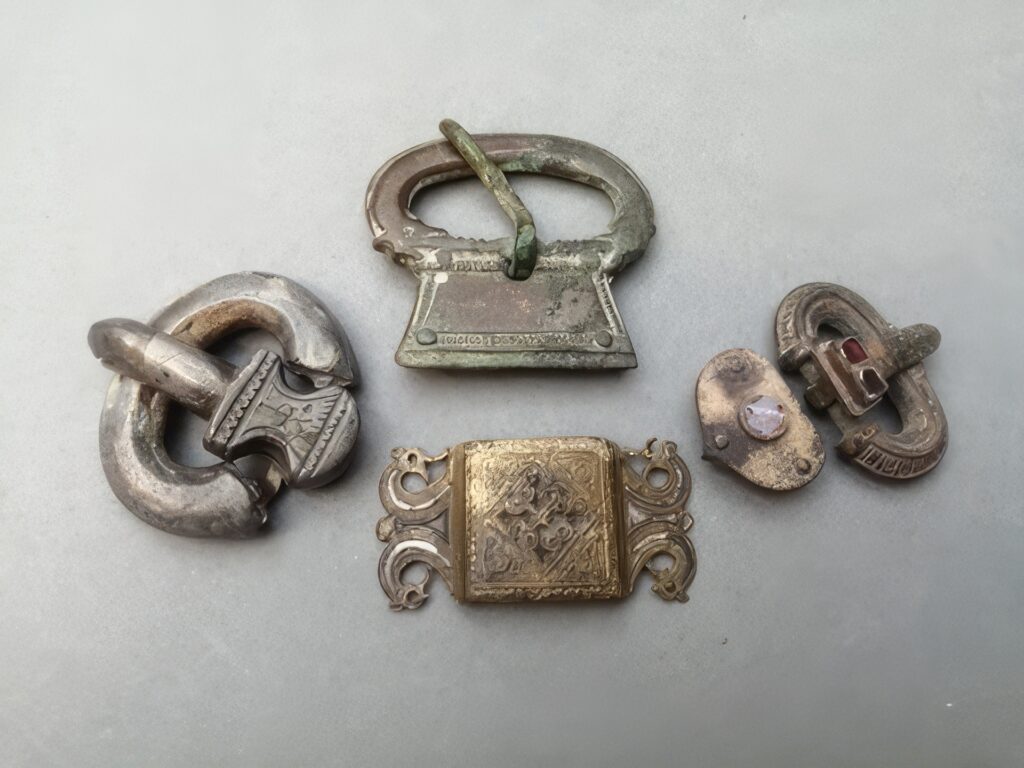
Three very different belt buckles were chosen, one heavy, plain buckle made of white metal, the second made of a copper alloy, with intricate cast details and garnet settings and the last, named a Dog buckle, is heavy with the heads of two dogs decorating the front. Other objects relating to belts were a belt mount and a belt slide. The mount is a small, flat, tapered plate, rounded at one end which would have sandwiched a thin leather strap in between its two parts.
The belt slide was a small, detailed square belt slide, gold plated with silver inlay on stylised dragons’ heads, shaped to accommodate a leather belt. During the years since it’s’ excavation, some of the detail had been lost, and dark patches had developed on the surface, needing further investigation. We also picked out a small, square metal mount with silver leaf on the front and detailed decoration.
This was also probably mounted on leather, and green corrosion had begun to obscure the decoration.
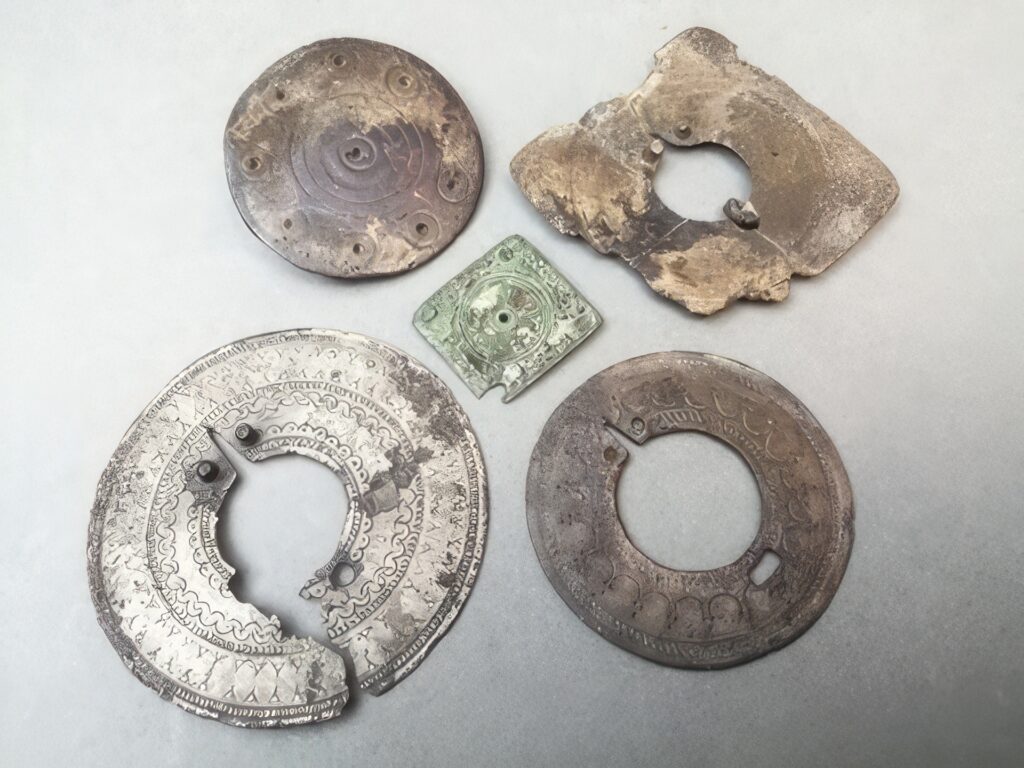
The Highdown hoard includes several brooches and James chose three ‘quoit brooches’ and a disc brooch with detailed decoration on the front. Quoit brooches worked a bit like a buckle, gathering fabric and securing it in place, as buttons had not yet been invented! These brooches were made with copper
or bronze, and one was coated in pewter, to look like silver.
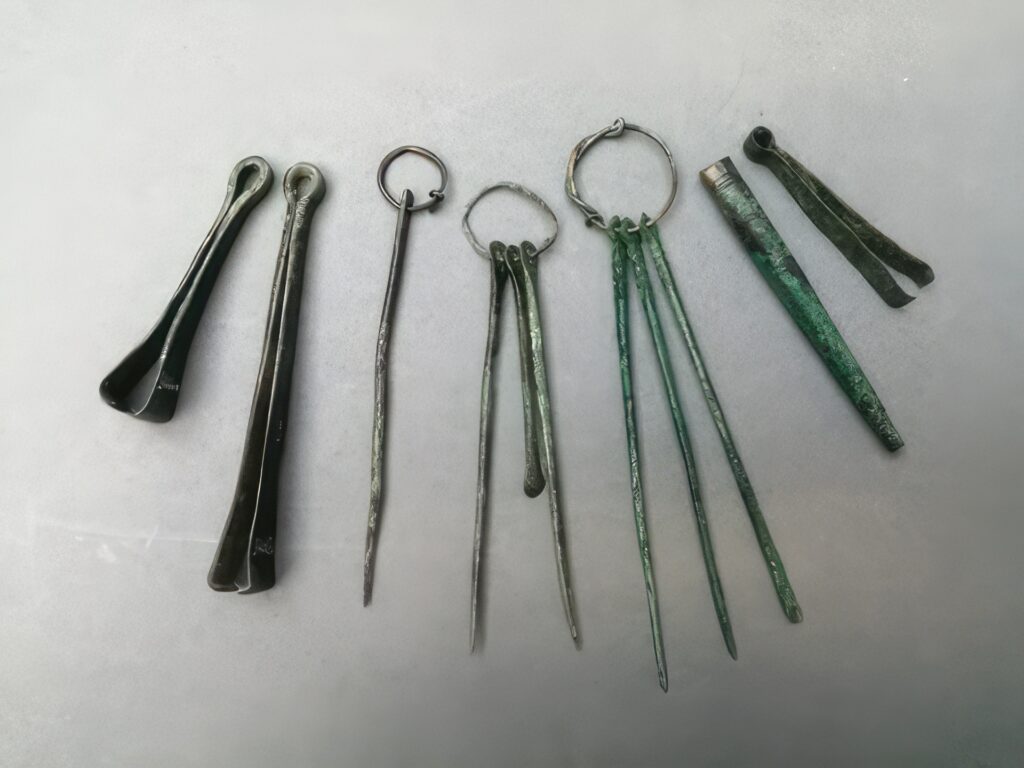
Three bronze Roman ‘toilet-sets’ and three pairs of tweezers were put aside for a check-over, as the
surfaces were showing light green corrosion. A toilet-set is a collection of small tools for personal
hygiene, threaded onto a ring. They often include several tools such as an ear scoop, toothpick, and other useful appliances. These personal objects are very recognisable and have hardly changed since Roman times. They were commonly placed in burials all over the world, showing that people then, were
just as concerned about appearance as we are now.
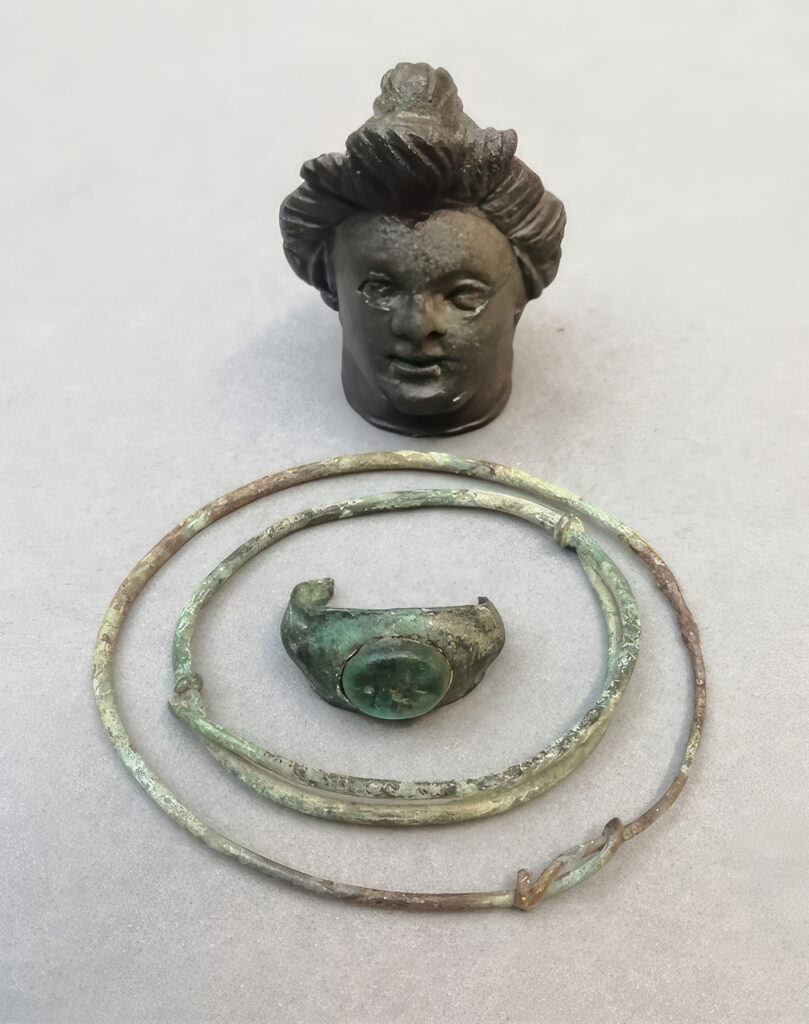
Included with the personal items was an object labelled ‘Bronze tube’, which is actually a ferrule – the metal band which holds bristles onto the end of a brush – I had to investigate further, and we will discover more about in the next blog post. Also with the Roman selection, was a small bronze head, labelled as ‘Faun’s Head’. We do not know what this was originally used for, but it might have been part of a small Roman statuette, which was ‘beheaded’ sometime before burial at Highdown.
It is always advisable to regularly check fragile items, so we picked out two delicate bronze wire bangles and part of a seal (or intaglio) ring. One bangle is much smaller than the other, and may have belonged to a child, and the surfaces were showing some pale green patches.
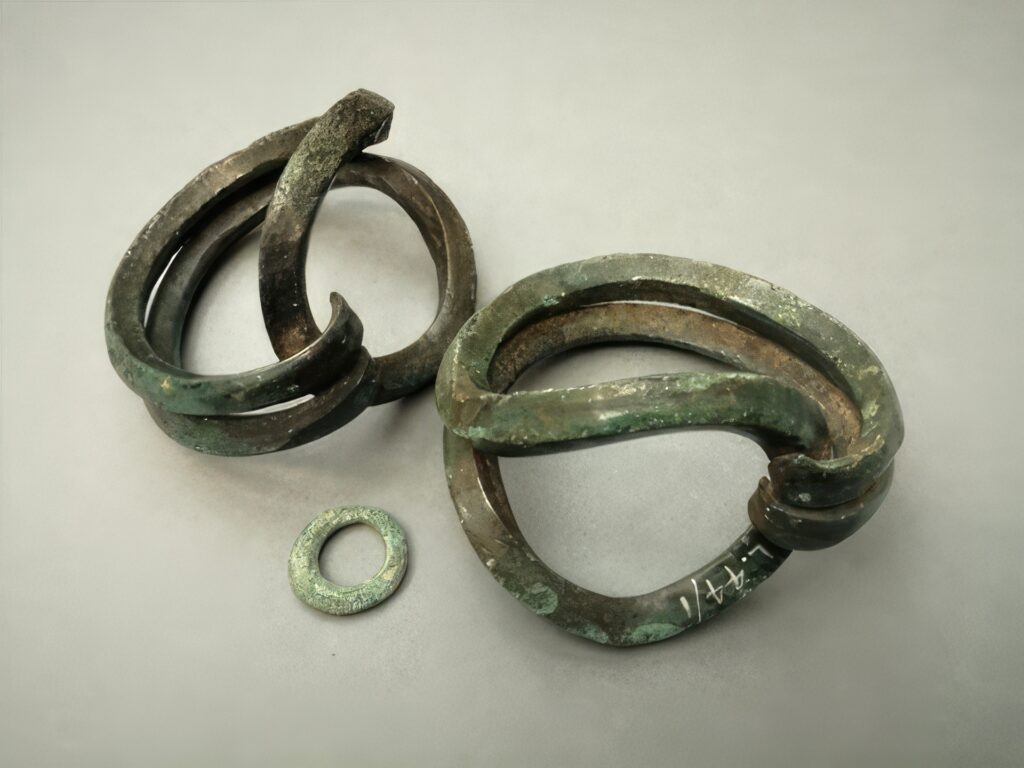
Finally, we went back to the Bronze Age case and had a closer look at two objects called Sussex – or Brighton – Loops. They are expertly worked and beautifully shaped from thick bronze rods, bent in half to form a loop at one end. The rod is then shaped into a circle, and the ends of the rod are curled back onto the loop. They appear to be arm ornaments but we do not know their function for certain. Only 39 of these have been discovered, all apart from two were discovered in Sussex, and their scarcity makes it tempting to believe that they were all created in the same workshop. A close look at them showed that some recent corrosion had developed, and we felt it was important to assess the condition of these rare and beautiful objects, and to halt any further damage.
In my next post I will be discussing what to look for when assessing an object, the tools we can use to find out more about the objects, and why research into the objects is important when deciding on a conservation path.


